Static control packaging must meet strict standards to protect your ESD-sensitive components. You'll need to follow ANSI/ESD S20.20 and IEC 61340-5-1 guidelines while ensuring your materials fall within specific resistance ranges: conductive (<1 x 10^4 ohms), static dissipative (1 x 10^4 to 1 x 10^11 ohms), or insulative (>1 x 10^11 ohms). Testing should occur in controlled environments with 12%±3% relative humidity at 73°±5°F, following protocols like ANSI/ESD STM11.11-2015 for surface resistivity measurements. Regular compliance checks and proper documentation are essential for maintaining quality control. Exploring these requirements in detail will help you establish a robust ESD protection program.
Understanding ESD Packaging Classification
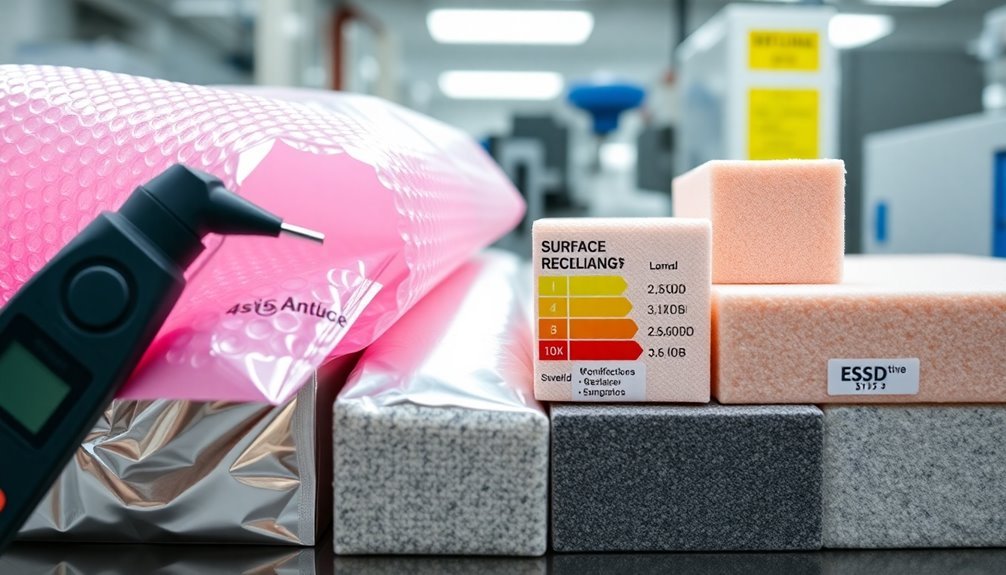
Within the domain of static control, ESD packaging classifications serve as the foundation for protecting sensitive electronic devices. You'll find three primary categories of ESD protective materials: conductive, static dissipative, and insulative, each defined by their specific surface resistivity measurements.
Conductive materials, with resistivity less than 1 x 10^4 ohms per square, offer permanent protection, while static dissipative materials range between 1 x 10^4 and 1 x 10^11 ohms per square. Standards development organizations actively collaborate to establish these specifications. This vital protection helps minimize the distribution hazards that can potentially damage electronic components during shipping and storage.
When you're selecting ESD packaging, you'll need to take into account that these materials must maintain their protective properties across varying environmental conditions, including changes in humidity and temperature. You can't rely on insulative materials for ESD protection, as their surface resistivity exceeds 1 x 10^11 ohms per square.
For highly sensitive components, you'll want to think about electrostatic shielding materials that provide Faraday Cage protection. Standard testing methods evaluate vital characteristics like surface resistivity and static decay to ascertain materials meet performance requirements.
These classifications aren't arbitrary – they're based on established standards and must comply with specifications outlined in IEC 61340-5-1 and ANSI/ESD S541 to guarantee reliable protection for your sensitive electronic devices.
Key Standards and Regulations
You'll need to understand two primary compliance frameworks that govern static control packaging: ANSI/ESD standards and military specifications (MIL-STDs).
The ANSI/ESD S20.20 and IEC 61340-5-1 establish the foundation for ESD control programs, while MIL-STD-1686 and MIL-PRF-81705 set specific requirements for military applications. Regular audits ensure ongoing compliance with these standards.
These standards define essential ESD classification requirements, including conductive (<1x10^4 ohms), static dissipative (1x10^4 to 1x10^11 ohms), and insulative (>1×10^11 ohms) materials. Common actions like handling sensitive equipment can generate up to 35,000 volts of static electricity that must be controlled through proper packaging.
Major Compliance Frameworks
The static control packaging industry operates under several critical standards and regulations that guarantee consistent protection of electronic components.
Environmental conditions significantly affect testing results, with surface resistance increasing as relative humidity drops. Regular testing is crucial since counterfeit packaging can severely compromise ESD protection. You'll need to comply with ANSI/ESD S541, which outlines essential requirements for packaging used to protect ESD-sensitive items during storage and transportation. This standard works in conjunction with ANSI/ESD S20.20, which provides the framework for developing thorough electrostatic discharge control programs.
When you're testing packaging materials, you'll need to follow specific test method standards. ANSI/ESD STM11.11 and STM11.12 guide you through surface and volume resistance measurements for static dissipative materials.
For evaluating bags specifically, you'll use ANSI/ESD STM11.31, which determines the effectiveness of electrostatic discharge shielding materials.
To maintain compliance, you must confirm your packaging meets strict testing requirements, including surface resistance below 1.0 x 10^11 Ω and electrostatic decay testing according to Mil-STD-3010C.
You'll also need to verify charge retention stays under 1.0 nC and static shielding performance remains below 20 nJ. These standards ensure your packaging provides reliable protection for sensitive electronic components throughout the supply chain.
ESD Classification Requirements
For decades, standardized ESD classification systems have helped protect electronic components from damage. You'll need to understand key standards like MIL-STD-1686 and ANSI/ESD S20.20, which define the Human Body Model (HBM) sensitivity classifications that guide your ESD control measures. The collaborative development process between manufacturers, users, and testing organizations ensures these standards remain relevant and effective. With over 1,900 facilities now certified globally, these standards have demonstrated their widespread adoption and effectiveness.
| Standard | Purpose | Key Requirements |
|---|---|---|
| MIL-STD-1686 | DoD ESD Control | HBM testing, classification levels |
| ANSI/ESD S20.20 | ESD Program Development | Program guidelines, testing protocols |
| IEC 61340-5-1 | Device Protection | ESD control requirements, monitoring |
To properly classify your components, you'll need to conduct specific tests including HBM, MM (Machine Model), and CDM (Charged Device Model) evaluations. These tests determine voltage sensitivity levels and help assign appropriate ESD classifications. Your classification data directly influences design hardening decisions and protective measures you'll implement.
You must regularly review and update your ESD control program to maintain compliance with these standards. Remember that classification isn't a one-time event – it's an ongoing process that requires continuous monitoring and evaluation to guarantee your ESD protection measures remain effective as technology evolves.
Material Testing Methods
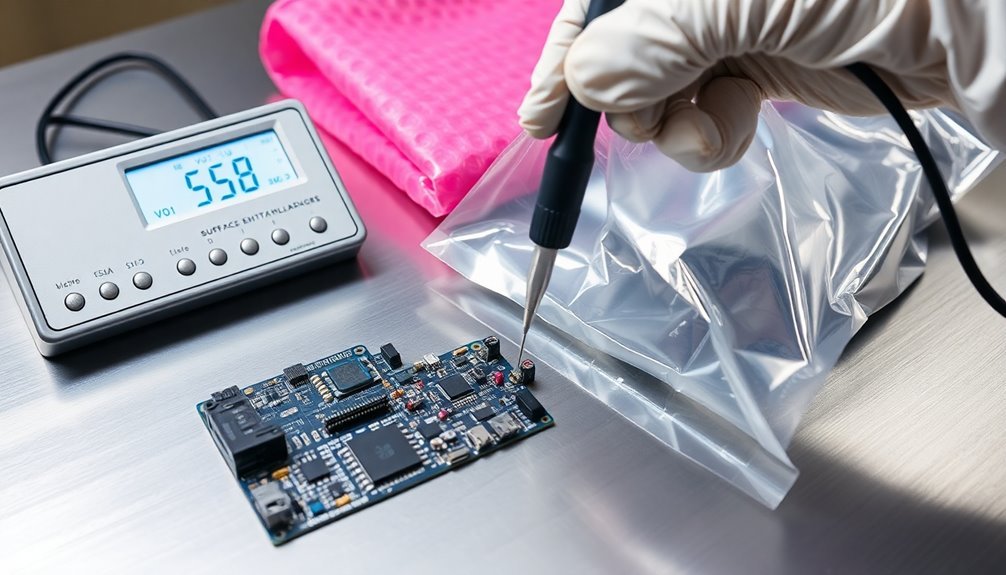
You'll need to conduct surface resistivity measurements according to ANSI/ESD STM11.11-2015, ensuring materials meet the required threshold of <1.0 x 10^11Ω under strict 12%±3%RH and 73°F±5°F conditions.
When performing static decay testing, you must follow Mil-STD-3010C Method 4046 protocols to verify the material's ability to dissipate charge within 2.0 seconds to 0 volts.
These critical tests can't be performed at ambient conditions, as proper preconditioning and controlled environmental parameters are essential for accurate, compliant results.
Surface Resistivity Measurement Protocols
Surface resistivity measurements require strict adherence to standardized testing protocols established by IEC and ASTM guidelines.
You'll need to maintain specific environmental conditions of 23°C and 50% relative humidity, conditioning your test samples for at least 24 hours before testing. The rapid nature of surface resistivity testing means you can obtain reliable results quickly, typically taking less than 5 minutes per reading. When you're ready to measure, you'll apply a direct voltage of 500V between two electrodes for 65 seconds. The Hioki SM7110 meter is particularly effective for these measurements due to its high stability and noise resistance.
To conduct accurate measurements, you'll use specialized equipment like the 6517B Electrometer or similar high-resistance meters with surface resistance measurement electrodes.
You'll want to employ the alternating polarity method to eliminate background currents that could affect your readings. For calculations, you'll use the formula ρs = Rs * 2π ln(R2/R1), considering the geometry coefficient of your electrode setup.
Your measurements should typically fall within 10^6 to 10^12 Ω range for materials with good insulation properties.
You'll need to pay particular attention when testing materials intended for critical environments like hospital operating rooms.
Remember to document your results in ohms or ohms/square, and use real-time measurement software to analyze and report your findings efficiently.
Static Decay Testing Methods
Testing static decay properties demands precise measurement of how quickly materials dissipate electrical charges. You'll need specialized equipment, including a static decay analyzer, environmental chamber, and high-voltage power supply, to conduct these tests accurately.
To perform static decay testing, you must first precondition your test specimens under controlled temperature and humidity conditions for approximately 48 hours.
You'll then place the specimen in a Faraday cage test fixture and apply a high voltage charge, typically 5,000 volts. Once charged, you'll ground the specimen and measure the time it takes for the voltage to decay to technical zero (usually below 50 volts).
You'll need to follow specific standards like Federal Test Standard 101C and MIL-STD-3010C to guarantee your results are valid and comparable.
The test data you collect will help classify materials based on their static dissipative properties. You can use real-time analysis software to record and analyze the decay times.
This testing method proves essential for multiple applications, including material R&D, manufacturing quality control, product certification, and workplace safety assessments.
You'll find it particularly valuable when evaluating the performance of static dissipative materials in packaging applications.
Environmental Control Requirements
The proper control of environmental conditions plays an essential role in ESD packaging evaluation and testing. You'll need to precondition your materials at 12%±3% relative humidity and 73°±5°F for a minimum of 48 hours before testing. This preconditioning isn't optional – it's vital for achieving consistent and reliable results.
When you're conducting ESD tests, you must maintain these same environmental conditions throughout the testing process. Don't make the mistake of testing at ambient conditions, as this can lead to inaccurate results. Many antistatic materials that pass testing at 50% RH may fail at 12% RH, which is why low humidity testing is critical for evaluating true performance.
To comply with ANSI/ESD S541 and ANSI/ESD S20.20 standards, you'll need to verify your test results in an accredited ESD laboratory. Your packaging materials must meet specific resistance limits to be properly classified as conductive, dissipative, or insulative.
Remember that environmental control isn't just about following procedures – it's about ensuring your materials will perform consistently in real-world applications, especially in dry conditions where static control is most challenging.
Shelf Life Management

You'll need to establish proper storage conditions with controlled temperature and humidity to maximize your ESD packaging's shelf life.
Your regular testing protocols should include annual compliance checks and immediate inspection of bags for any physical damage that could compromise their protective properties.
Implement a First In First Out (FIFO) system to track inventory effectively, ensuring older stock is used first and maintaining clear documentation of purchase dates and lot numbers.
Storage Environment Best Practices
Proper storage environment management plays a critical role in maintaining the effectiveness of ESD packaging materials throughout their shelf life. You'll need to establish a controlled environment that protects these materials from degradation factors while guaranteeing they maintain their static control properties.
| Storage Factor | Best Practice |
|---|---|
| Temperature & Humidity | Store in climate-controlled area away from extremes; monitor levels regularly |
| Light Exposure | Keep materials away from direct sunlight; use UV-filtered lighting |
| Ventilation | Maintain good air circulation to prevent moisture buildup |
When setting up your storage area, you'll want to implement a FIFO inventory management system and track materials by lot numbers. This guarantees you're using older materials first and maintaining proper rotation. Don't forget to conduct periodic testing of stored materials to verify they still meet ANSI/ESD S541 standards.
You should store your ESD packaging in a dry, well-ventilated space that's protected from temperature fluctuations. Regular audits of storage conditions will help you identify potential issues before they affect material quality. Remember to follow vendor-specific guidelines, as different ESD materials may have unique storage requirements based on their composition and intended use.
Regular Testing Protocols
Through regular testing protocols, maintaining ESD packaging integrity becomes a systematic process that requires specific environmental conditions and measurement procedures.
You'll need to conduct testing at 12%±3% relative humidity and 730±50°F for a minimum of 48 hours, as ambient conditions won't suffice for accurate ESD measurements. Using concentric ring fixtures, you must verify that surface resistivity remains below 1 x 10^11 ohms per square for static shielding materials.
To guarantee ongoing compliance with ANSI/ESD S541 standards, incorporate these critical testing components:
- Perform high voltage discharge tests, simulated vibration assessments, and environmental exposure evaluations
- Verify incoming materials with proper traceability information and manufacturer's lot codes
- Document all test results and maintain regular verification schedules to prevent material degradation
Your ESD packaging assessment should align with ANSI/ESD S20.20 requirements, including thorough testing of all packaging materials used in your ESD-sensitive processes.
You'll need to maintain detailed records of test results and implement immediate corrective actions when measurements fall outside acceptable ranges.
Remember to check adhesion properties and labeling requirements as part of your regular testing protocol to guarantee complete packaging functionality.
FIFO Implementation Guidelines
Beyond testing protocols, maintaining static control packaging requires careful attention to inventory management.
To implement effective FIFO controls, you'll need to establish a systematic approach that guarantees older inventory moves out first while maintaining static protection integrity.
Start by organizing your inventory with clear date labeling and categorization systems. You'll want to use FIFO-compliant shelving that makes older stock easily accessible, complemented by automated storage systems where feasible.
Train your staff thoroughly on FIFO procedures, emphasizing the critical nature of proper rotation for static-sensitive materials.
Implement specialized inventory management software that tracks static control packaging through its shelf life. You'll find these systems particularly valuable for monitoring expiration dates and maintaining compliance records.
Design your warehouse layout to support efficient FIFO operations, incorporating pallet racking systems and clear signage that facilitates proper rotation.
Regularly audit your inventory processes to verify FIFO compliance and identify any gaps in your procedures.
Consider using demand forecasting tools to optimize your inventory levels and guarantee you're not maintaining excess stock that could exceed its effective static protection period.
Static Shielding Properties
Static shielding properties represent the cornerstone of effective ESD protection in packaging materials. When you're working with sensitive electronic components, you'll need to understand how these materials create a protective barrier through their multi-layered construction. The composition forms a Faraday cage that shields against both internal and external static charges, while providing thorough ESD protection.
Three vital aspects of static shielding properties:
- The inner polyethylene layer dissipates static buildup, preventing charge accumulation that could damage your components.
- The middle metallic layer, made of carbon or aluminum, grounds potentially harmful charges before they reach your product.
- The outer polyester layer with its dissipative coating removes external electrical charges, completing the protective barrier.
You'll find that proper handling is essential to maintain these protective properties. Don't use staples, as they'll compromise the shielding effect, and make sure you're sealing the bags completely – even small gaps can lead to protection failure.
When you're packing items with sharp edges, you'll need additional padding to prevent punctures that would render the shielding ineffective. These properties make static shielding bags essential for transporting and storing static-sensitive electronics safely.
Package Design Fundamentals
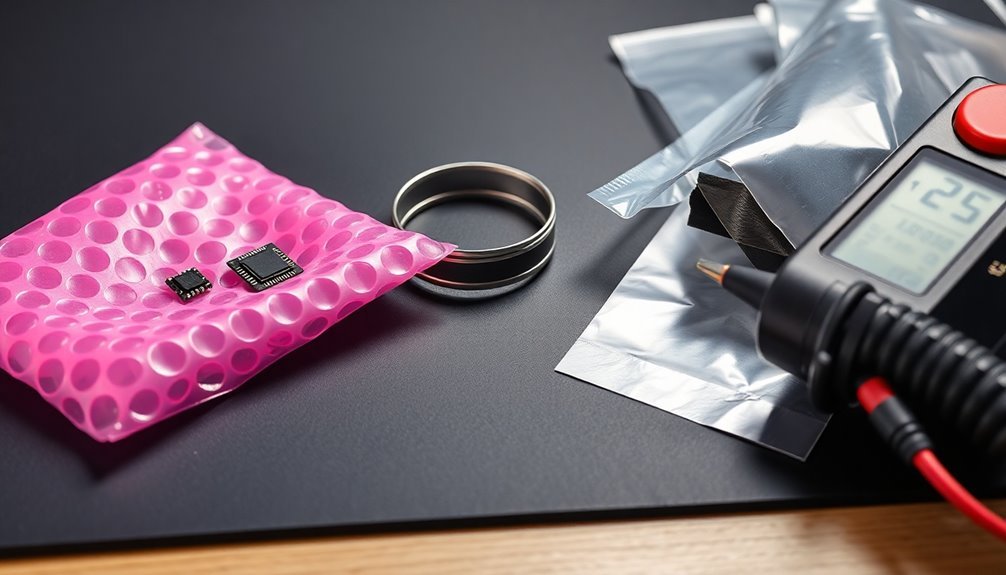
The fundamentals of ESD package design require careful attention to both environmental factors and material selection. You'll need to take into account humidity control, temperature management, and proper storage conditions to maintain the effectiveness of your ESD packaging materials. When designing ESD packages, it's essential to account for both EPA (ESD Protected Area) and non-EPA environments.
| Design Element | Requirement |
|---|---|
| Material Type | Must be conductive or dissipative for EPA use |
| Grounding | All conductors must connect to ground |
| Protection Level | Must match device sensitivity level |
| Physical Structure | Requires cushioning for sensitive items |
| Environmental Control | Temperature and humidity monitoring |
Your package design should incorporate appropriate shielding materials that comply with ANSI/ESD S541 and MIL-PRF-81705 standards. When selecting materials, you'll need to evaluate the ESD sensitivity of your devices and the intended distribution environment. Don't forget to take into account the shelf life of your packaging materials – they'll require periodic testing to guarantee continued compliance. For items requiring rigorous handling, you must include additional cushioning and protection. Remember that your design needs to account for both physical protection and static discharge prevention throughout the entire supply chain.
Quality Assurance Protocols
Implementing effective quality assurance protocols requires a systematic approach to testing and verification of ESD packaging materials.
You'll need to follow ANSI/ESD S541 guidelines for testing methods while guaranteeing your materials meet classification requirements for conductive, static dissipative, or insulative properties.
To maintain compliance and protect sensitive components, you should focus on these critical testing elements:
- Regular material verification through standardized test methods outlined in ANSI/ESD S541
- Annual spot checks and audits to confirm packaging continues to meet specifications
- Recertification testing based on manufacturer's recommended intervals
You'll want to establish a controlled storage environment that protects your ESD packaging from temperature extremes, sunlight, and moisture.
Implement a FIFO inventory system to guarantee packaging materials don't exceed their typical one-year warranty period.
When working with military applications, you must comply with MIL-PRF-81705 for flexible packaging materials and follow MIL-STD-129 for proper marking and labeling procedures.
For international operations, you'll need to align your testing protocols with both ANSI/ESD S20.20 and IEC 61340-5-1 standards to maintain global consistency in your quality assurance program.
Marking and Identification Guidelines

Building on proper quality assurance protocols, correct marking and identification of ESD packaging guarantees consistent traceability and compliance throughout your supply chain.
You'll need to verify all bags carry manufacturer information, date codes, and appropriate ANSI/ESD S8.1 symbols that clearly identify the packaging type and its ESD control properties.
Follow ANSI/ESD S541 and S11.4 Section 6.0 guidelines for marking requirements. You must maintain clear, readable labels that won't deteriorate during the product's lifecycle.
These markings enable quick identification of ESD-sensitive items and help verify authentic packaging materials.
You'll need to implement regular compliance verification procedures to maintain ESD control standards. Conduct routine audits to verify all packaging meets ANSI/ESD S20.20 requirements and remove any non-compliant materials immediately from your operations.
Maintain detailed documentation of your marking and identification systems. Keep thorough records for each batch of ESD packaging materials, updating them regularly.
This documentation supports your traceability efforts during storage, shipping, and handling processes, helping you verify packaging materials effectively throughout the product lifecycle.
Storage and Handling Procedures
Proper storage and handling of ESD packaging materials requires strict environmental control at 73°F±5°F (23°C±3°C) and 12%±3% relative humidity for at least 48 hours.
You'll need to store these materials in a way that prevents physical damage while maintaining their static control properties. When handling ESD-sensitive items, it's vital to use packaging that provides complete protection from electrostatic hazards.
To guarantee effective ESD protection, you must follow these critical procedures:
- Maintain continuous grounding of all conductors and dissipative items through proper handling techniques and equipment.
- Store packaging materials in controlled environments that prevent degradation of their static control properties.
- Handle all ESD packaging with care to avoid compromising their protective capabilities.
You'll need to implement proper grounding and equipotential bonding systems throughout your storage and handling processes.
It's important to evaluate your packaging materials regularly for their static charge control capabilities in your specific storage environment.
Remember that your packaging design should prevent the materials themselves from generating harmful static charges.
Compliance Documentation Requirements
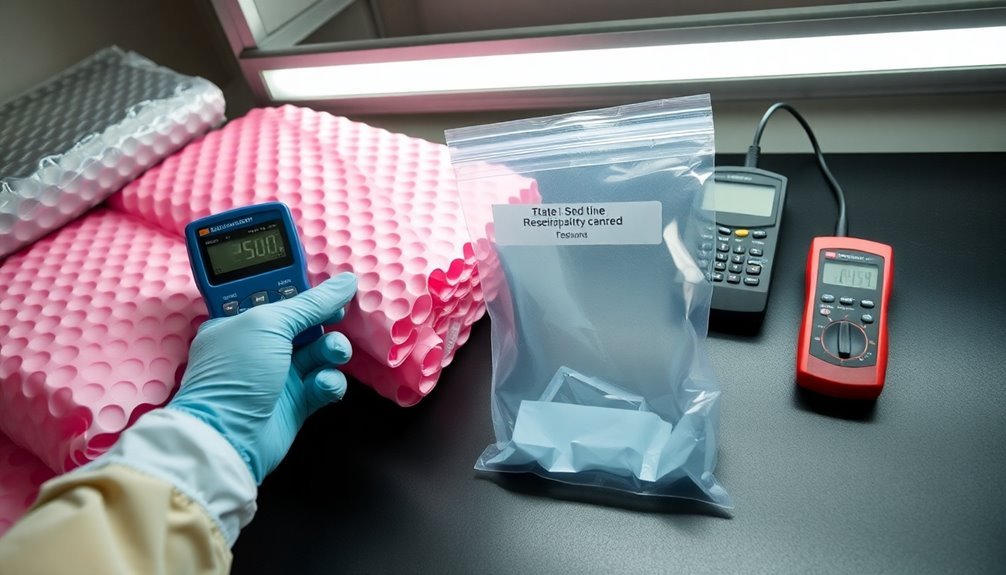
Compliance with ESD packaging standards requires thorough documentation that adheres to ANSI/ESD S541, ANSI/ESD S20.20, and IEC 61340-5-1 guidelines.
You'll need to maintain detailed records of your packaging materials' properties, including conductivity measurements for conductive materials and resistance readings for dissipative materials.
Your documentation must include test results that verify packaging materials meet the specified requirements. You should perform periodic testing of ESD bags and implement a FIFO inventory system to guarantee material freshness.
Keep records of storage conditions and annual spot check audits to demonstrate ongoing compliance with standards.
For labeling documentation, you'll need to follow MIL-STD-129 requirements, including the application of Special Marking Code "39" for ESD-sensitive items.
Your records should detail the proper wrapping, cushioning, and marking procedures for each type of ESD item you handle. If you're unsure about any packaging requirements, submit a Post Award Request (PAR) for clarification.
Maintain documentation of your material classifications, whether they're conductive, static dissipative, or static shielding.
You must also record the intended use of each material type, particularly noting whether they're approved for use inside or outside an EPA.
Frequently Asked Questions
Can Damaged ESD Packaging Be Repaired With Specialized ESD-Safe Tape?
You can repair damaged ESD packaging with specialized ESD-safe tape for minor fixes, but you'll need to guarantee the repairs don't compromise the package's protective properties and still meet ANSI/ESD S541 standards.
How Often Should ESD Packaging Materials Undergo Recertification Testing?
You'll need to test your ESD packaging based on usage frequency and risk factors. It's recommended to verify materials quarterly, but you should adjust testing intervals based on your specific operational needs and material durability.
What Happens if ESD Packaging Accidentally Gets Wet?
If your ESD packaging gets wet, you'll need to replace it immediately. Moisture compromises the packaging's static control properties and can cause corrosion, delamination, and potential device failure in your protected components.
Are There Specific Disposal Requirements for Expired ESD Packaging Materials?
You'll need to follow local and federal regulations when disposing of expired ESD packaging. Mark them clearly, separate from usable materials, and consider recycling options. Don't dump them in unauthorized locations or landfills.
Can Standard Shipping Labels Affect the ESD Protection Properties?
Yes, your standard shipping labels can compromise ESD protection if they're not made from static dissipative materials. They'll generate unwanted static charges and interfere with your packaging's protective properties, potentially damaging sensitive components.
In Summary
You'll need to carefully follow these essential standards and testing requirements to protect your sensitive electronic components from ESD damage. Stay current with classifications, testing methods, and handling protocols while maintaining proper documentation. Remember that effective static control packaging isn't just about the materials – it's about implementing a complete system of controls, from storage through shipping, to guarantee product integrity.

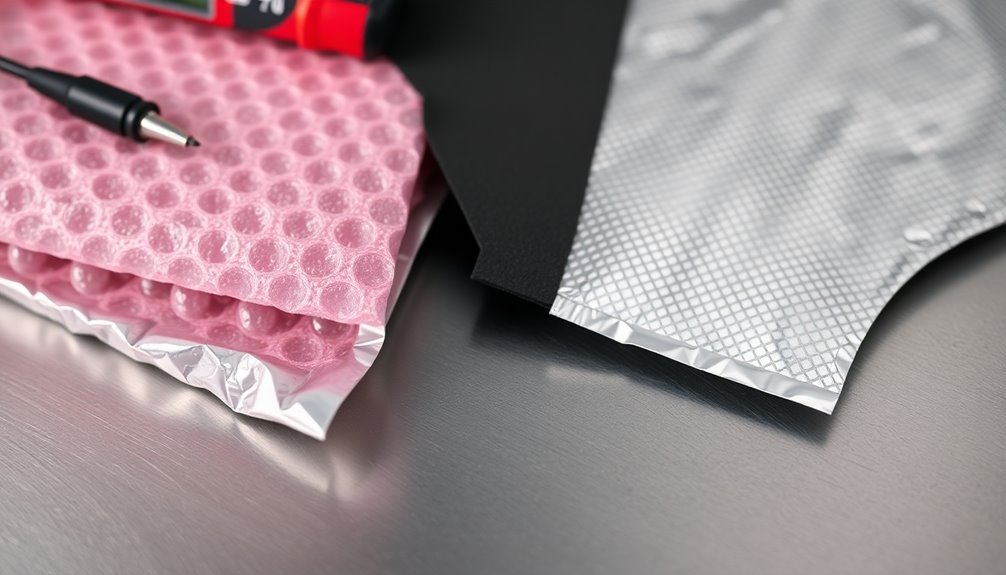



Leave a Reply